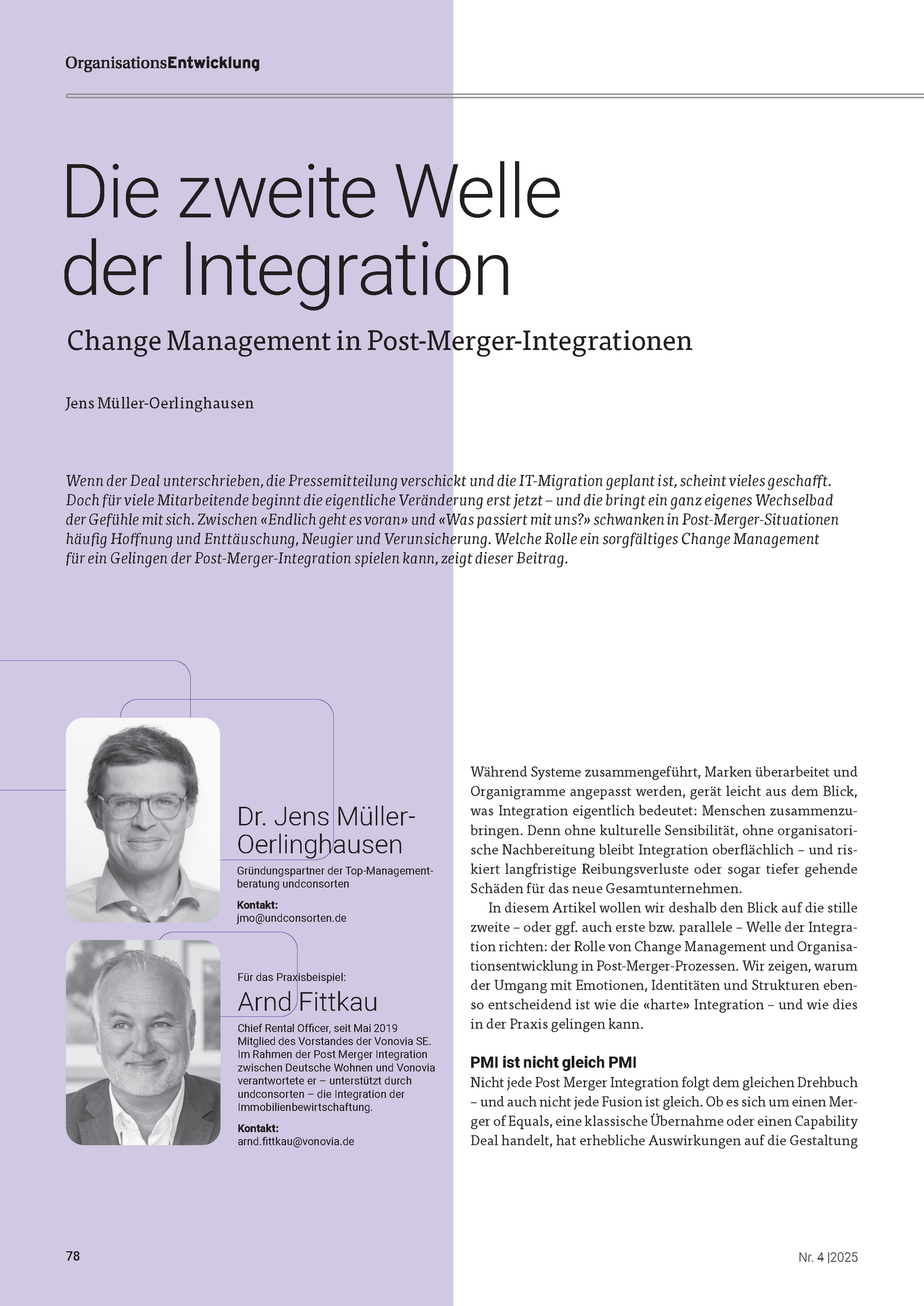
The second wave of integration
Change management in post-merger integrations
Once the deal has been signed, the press release sent out and the IT migration planned, a lot seems to be done. But for many employees, the real change is only just beginning - and this brings with it its very own rollercoaster of emotions. In post-merger situations, hope and disappointment, curiosity and uncertainty often fluctuate between "Things are finally moving forward" and "What will happen to us?". This article shows the role that careful change management can play in the success of post-merger integration.
While systems are being merged, brands revised and organisational charts adapted, it is easy to lose sight of what integration actually means: bringing people together. Without cultural sensitivity and organisational follow-up, integration remains superficial - and risks long-term frictional losses or even deeper damage to the new company as a whole. In this article, we therefore want to focus on the second wave of integration: the role of change management and organisational development in post-merger processes. We show why dealing with emotions, identities and structures is just as crucial as the "hard" integration - and how this can succeed in practice. After a brief introduction, we provide a concrete insight into a current PMI project and share our learnings from its implementation.
PMI is not just PMI
Not every post-merger integration follows the same script - and not every merger is the same either. Whether it is a merger of equals, a classic takeover or a capability deal has a significant impact on the design of the integration process. Depending on the type of deal, the objectives, depth of integration and emotional impact vary significantly: while a merger of equals usually requires a balancing act between identities, takeovers often involve power asymmetries and the associated irritations - often coupled with a feeling of "losing" on the part of the acquired company. This gives rise to key questions for change and integration management: Which operating model - i.e. which processes, roles and responsibilities - should apply in the future? How can new best practices be identified and adopted despite the time pressure, even with a clear takeover and integration into the system of the acquiring company? How will the teams be put together - integrated, newly formed or strictly separated along old lines? What learning and training needs arise from the new structures? How do we deal with overcapacity or shifts in spatial requirements? And last but not least: When and how can we communicate openly at all - in the area of conflict between management guidelines, the works council and the actual willingness to change? To make the complexity more tangible, we have compared typical merger types with their effects on key areas of action - from the mission statement to the organisation and communication. The table serves as an initial orientation for change managers and shows how different the challenges - and therefore also the approaches - can be. Effects / aspects Merger of equals Takeover (acquisition) Capability deal Mission statement & vision Shared vision, co-creation, balance of identities Mission statement of the buyer dominates, integration of the target's goals Focus on transfer of expertise, preservation of specialist knowledge Operating model & organisation Integration on equal terms, often new structures "best of both worlds" Adoption of the buyer's operating model, rapid harmonisation Partial integration, protection of the target's core competencies Culture & change management Change management Focus on equality, breaking down silos, team building Risk of loss of identity at the target, targeted employee retention measures Protection of the smaller partner's culture, employee retention critical Communication & integration team Transparent, participative communication, mixed teams Clear top-down communication, change agents at the target Sensitive communication, targeted integration teams The following practical example, which was created with the kind assistance of Arnd Fittkau (Chief Rental Officer, Vonovia SE), highlights a special constellation: In purely formal terms, it was of course a takeover - including the introduction of systems and processes. At the same time, the integration took place under the motto "Growing together" and brought together two DAX 40 companies, each with a strong identity. Against this backdrop, the declared aim was to retain the tried and tested aspects of Deutsche Wohnen. It was precisely in this area of tension - between strategic harmonisation and cultural appreciation - that the key challenges for change management lay. And equally valuable learning moments.
Practical example:
"Growing together" - integration of Deutsche Wohnen into Vonovia
The practical example, which was created with the kind assistance of Arnd Fittkau (Chief Rental Officer, Vonovia SE), highlights a special constellation: in purely formal terms, it was of course a takeover - including the introduction of systems and processes. At the same time, the integration took place under the motto "Growing together" and brought together two DAX 40 companies, each with a strong identity. Against this backdrop, the declared aim was to retain the tried and tested aspects of Deutsche Wohnen. It was precisely in this area of tension - between strategic harmonisation and cultural appreciation - that the key challenges for change management lay. And equally valuable learning moments.
The initial situation
Vonovia acquired a majority stake in Deutsche Wohnen at the end of 2021. For the German property landscape, it quickly became clear that two strong and traditional companies were coming together. - However, the challenge of uniting companies of this size with different corporate cultures and working methods into a harmonious whole was not an everyday task, even for Vonovia, which is experienced in integration. The ambitious timeline for the process integration, the creation of new locations and business units and the need to ensure the smoothest possible transition for all customers required a carefully planned approach. A comprehensive integration project was therefore launched with the aim of working within Vonovia's common structures and processes by 1 January 2023. As part of this integration project, undconsorten supported the change management activities of Vonovia's core business - the rental organisation.

To read this article in full, please subscribe to the 04 | 2025 issue of the Journal for Organisational Development focussing on the time dimension in change.
